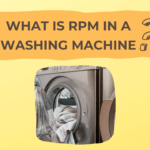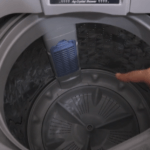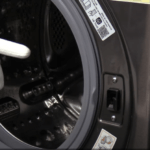What is a Front Load Washing Machine? A Comprehensive Guide
Synopsis
A front-load washing machine is a type of washing machine where clothes are loaded from the front side, and the drum rotates horizontally, moving clothes through the water by gravity and rotation. It is known for its energy efficiency, water conservation, and gentle cleaning process.
- Synopsis
- Introduction: What is Front Load Washer
- What is a Washing Machine?
- What is a Front Load Washing Machine?
- Features of a Front Load Washing Machine
- Advantages of a Front Load Washing Machine
- Disadvantages of a Front Load Washing Machine
- Tips for Using a Front Load Washing Machine
- Difference Between Front Load and Top Load Washing Machines
- Difference Between Front Load and Top Load Washing Machines – At a Glance
- Conclusion
Introduction: What is Front Load Washer
In the modern world, washing machines have become an essential household appliance.
They not only save time but also clean clothes more efficiently.
Among the various types of washing machines available in the market, front-load washing machines are popular.
This article aims to provide a comprehensive understanding of front-load washing machines.
What is a Washing Machine?
A washing machine is a home appliance that is used to wash laundry.
The history of washing machines dates back to the 18th century.
Over the years, washing machines have evolved significantly, and today they play a crucial role in our daily lives.
What is a Front Load Washing Machine?
A front-load washing machine is a type of washing machine where clothes are loaded from the front side.

The drum in the machine rotates horizontally, and clothes are moved through the water by gravity and the rotation of the drum.
Features of a Front Load Washing Machine
Front-load washing machines come with several key features.
They are known for their energy efficiency and use less water compared to top-load machines.
They also have a larger capacity, which means they can wash more clothes in a single cycle.
RELATED READING: 6 Best Front Load Washing Machines Under 30000
Advantages of a Front Load Washing Machine
Here are the key benefits of a front-load washing machine:
- Energy Efficiency: Front-load washing machines are known for their energy efficiency. They use less electricity compared to top-load machines, which can lead to significant savings on your energy bills over time.
- Water Conservation: These machines use less water than top-load machines. They achieve this by tumbling clothes through the water rather than filling the drum with water.
- Gentle on Clothes: The tumbling action used by front load machines is much gentler on clothes than the agitator used in top load machines. This can result in less wear and tear on your clothes, helping them last longer.
- Higher Spin Speeds: Front loaders typically have higher spin speeds which means clothes come out drier, reducing the time and energy needed for drying.
- Larger Capacity: Front-load washing machines typically have larger capacities than top-load machines. This means you can wash more clothes in a single cycle, saving time and energy.
RELATED READING: How To Load a Front Load Washing Machine?
Disadvantages of a Front Load Washing Machine
Here are the key disadvantages of a front-load washing machine:
- Higher Initial Cost: Front-load washing machines are generally more expensive to purchase upfront than top-load machines. This can be a significant factor for budget-conscious consumers.
- Longer Wash Cycles: Due to their tumbling action and energy-efficient design, front-load machines typically have longer wash cycles than top-load machines. This could be inconvenient for those who prefer quick wash cycles.
- Ergonomics: Since the door is located on the front of the machine, users may need to bend or kneel to load and unload laundry, which might not be comfortable for everyone.
- Maintenance: Front-load washing machines require more maintenance to prevent issues like mold and unpleasant odors. This includes regularly cleaning the rubber seal around the door and leaving the door open to air out after use.
Remember, while front-load washing machines have these disadvantages, they also offer many advantages such as energy efficiency, water conservation, and gentle cleaning.
It’s important to consider both the pros and cons when choosing a washing machine.
RELATED READING: How to use Front Load Washing Machine?
Tips for Using a Front Load Washing Machine
Here are some tips for using a front-load washing machine:
- Proper Loading: Ensure that you load your clothes evenly to maintain balance during the spin cycle. Overloading or underloading can cause the machine to become unbalanced, leading to inefficient washing and potential damage to the machine.
- Use High-Efficiency Detergent: Front-load washing machines require high-efficiency (HE) detergent, which is specially formulated to produce fewer suds. Using regular detergent can result in too many suds and can damage the washing machine.
- Clean Regularly: To prevent mold and mildew, it’s important to clean your machine regularly. This includes wiping down the door seal and running a cleaning cycle with a washing machine cleaner.
- Leave the Door Open After Use: After each wash, leave the door open to allow the inside of the machine to dry out. This helps prevent the growth of mold and mildew.
- Remove Clothes Promptly: Try to remove your clothes from the machine as soon as the cycle is finished. Leaving damp clothes in the machine can lead to the growth of mold and mildew.
- Use the Right Settings: Make sure to use the right settings for each load. Different fabrics and levels of dirtiness may require different wash settings.
Remember, taking care of your front-load washing machine can help it last longer and perform better.
Difference Between Front Load and Top Load Washing Machines

When choosing a washing machine, one of the key decisions you’ll need to make is between a front load and a top load washing machine. Here are some of the main differences:
- Design: The most obvious difference is the location of the door. Front-load machines have the door on the front, while top-load machines have the door on the top. This affects how you load and unload your laundry.
- Washing Mechanism: Front-load machines use a tumbling action where clothes are lifted to the top of the drum and then dropped into the water. On the other hand, top-load machines typically use an agitator or impeller to move clothes around the drum.
- Water Usage: Front-load machines use less water than top-load machines. They achieve this by tumbling clothes through the water rather than filling the drum with water.
- Energy Efficiency: Front-load machines are generally more energy-efficient than top-load machines. This is because they use less water and have faster spin cycles, which means clothes need less time in the dryer.
- Capacity: Front-load machines typically have a larger capacity than top-load machines. This means you can wash more clothes in a single cycle.
- Price: Front-load machines are usually more expensive than top-load machines. However, the higher initial cost can be offset by the energy and water savings over time.
- Maintenance: Front-load machines require more maintenance to prevent issues like mold and unpleasant odors. This includes regularly cleaning the rubber seal around the door and leaving the door open to air out after use.
RELATED READING: Why Front Loading Washing Machines Are Better?
Difference Between Front Load and Top Load Washing Machines – At a Glance
Here’s a brief comparison between front-load and top-load washing machines in a table format:
| Feature | Front Load Washing Machine | Top Load Washing Machine |
|---|---|---|
| Design | The door is on the top. | The door is on the top. |
| Washing Mechanism | Less energy-efficient compared to front-load machines. | Uses an agitator or impeller to move clothes around the drum. |
| Water Usage | Uses less water by tumbling clothes through the water. | Uses more water as the drum is filled with water. |
| Energy Efficiency | More energy-efficient due to less water usage and faster spin cycles. | Typically has a smaller capacity compared to front-load machines. |
| Capacity | Typically has a larger capacity, allowing more clothes per cycle. | Requires less maintenance compared to front-load machines. |
| Price | Generally more expensive upfront but can be offset by energy and water savings over time. | Generally less expensive upfront. |
| Maintenance | Requires more maintenance to prevent issues like mold and unpleasant odors. | Requires less maintenance compared to front load machines. |
Remember, both types of washing machines have their pros and cons.
Your choice will depend on your personal preferences, budget, and laundry needs.
RELATED READING: Best Front Load Washing Machines
Conclusion
Front-load washing machines offer many benefits, including energy efficiency, water conservation, and gentle cleaning.
However, they also have some drawbacks, such as higher initial costs and longer wash cycles.
By understanding these factors, you can make an informed decision when purchasing a washing machine.
This article provides a comprehensive overview of front-load washing machines.
However, the features and specifications may vary based on the brand and model.
About Author
You can ‘meet your author’ on the About Author page here.
TRENDING NOW






Leave a Reply